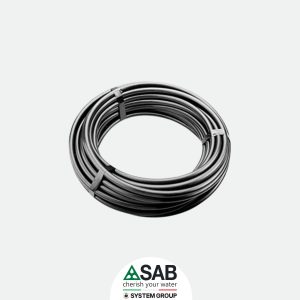Drip Irrigation for Apple Trees: Practical Guide with SAB Products
Introduction: Why Choose Drip Irrigation?
Drip irrigation is an efficient and sustainable solution for water management in agriculture. This irrigation method permits to deliver water directly to the plant’s root area, reducing waste and optimizing water absorption. While drip tapes and drip lines are commonly used for vegetable crops, an above-ground system with rigid pipes and inline drippers are typically used for orchards. This system is ideal not only for orchards but also for bushes, vineyards, and olive groves, and is applicable in both open fields and greenhouses. In this article, we will explore a practical example: the installation of a drip irrigation system for apple orchards in a school nursery.
System Design Description
Our case study involves a school orchard consisting of two parallel rows of apple trees, each 6 meters long, for a total of 10 trees. A fundamental requirement for the installation of any irrigation system is the availability of a water source, which was already provided in this specific case.

Materials used:
- PE100 Mainline Pipe (32mm diameter): high-density polyethylene compliant with UNI EN 12201-2 standards, durable, and safe for water management.

- PEBD Pipe (20mm diameter): low-density polyethylene pipe, ideal for above-ground or underground drip irrigation systems.

- Pipe Supporting Hook: keeps the pipe firm and prevents twisting.
- Rambo Dripper: made from UV-resistant polypropylene, these drippers may guarantee different flow rates based on their internal special design. They deliver the right amount of water to each individual plant; in this specific case, the use of pressure-compensating drippers was not necessary, as the terrain was not characterized by slopes.
- Hollow punch for pipes: creates precise holes for installing the drippers.
- Compression Valves: control the water flow in the system for optimized water resource management.
- Blueseal Compression Fittings: Ensure secure and durable connections on mainlines, with up to 16 bar working pressure.
Design and Installation: Stages
Here are some key steps to set up a drip irrigation system for a tree cultivation, in this case, an apple orchard:
1.Connection to the Water Source: the PE100 mainline pipe has to be connected to the water source.
2.Connection to the Distribution Pipe: PE100 pipe Ø32 is connected to the Ø20mm PEBD distribution pipe by using 90° compression elbows.

3.Positioning the Distribution Pipe: the PEBD pipe is unrolled along the orchard.

4.Securing the Pipe to the Trees: the pipe is lifted off the ground and anchored to the tree branches with iron wires.
5.Supporting Hooks Installation: the hooks are positioned, and the PEBD pipe is hooked to prevent twisting and tangling.

6.Installation of the Compression Valve: this compression threaded valve allows you to open or close the water flow in the system.

7.Punching the Pipe for the Drippers: using the hollow punch, the necessary holes are made near the trees to ensure the most precise irrigation possible.

8.Inserting the Drippers: rambo drippers are installed where the holes have been made, and the system is ready to be used

Conclusion
By following some simple steps described above, the system is ready to be used. Drip irrigation for orchards offers a straightforward and effective solution for water management, ensuring water savings and efficiency. With SAB products, even a small system like the one in a school nursery can demonstrate how irrigation of fruit trees can be optimized with a practical and replicable system.
This example not only highlights the ease of installation but also shows how a similar system can be scaled for larger orchards. With the necessary adjustments and integrations, the system can be adapted for other trees like apricots, cherries, citrus, and many others, improving productivity and reducing water waste.









